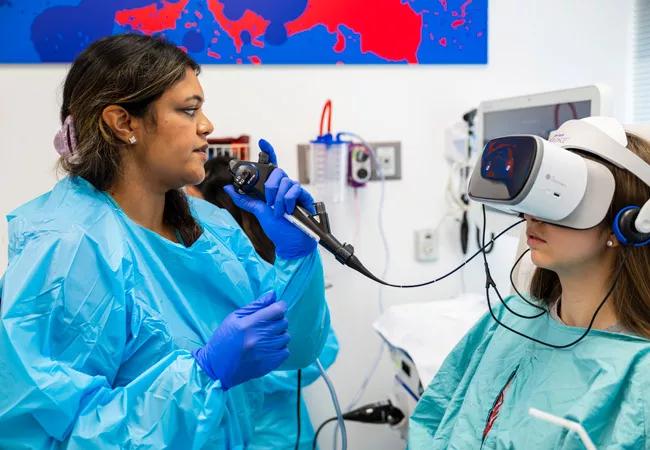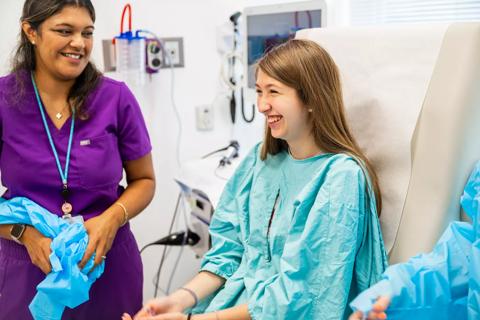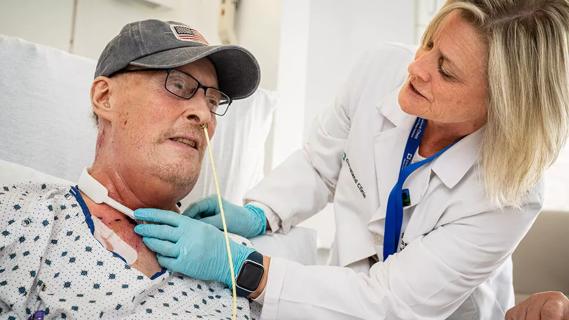3 pediatric gastroenterologists discuss advances in their diagnostic toolkits

Getting to the root of esophageal dysfunction can be challenging for providers and distressing for patients. Puzzling etiology and varied clinical presentation have led to unanswered questions in the field. However, pediatric gastroenterologists at Cleveland Clinic Children’s are using the most innovative approaches to assess esophageal issues and effectively manage care.
Advertisement
Cleveland Clinic is a non-profit academic medical center. Advertising on our site helps support our mission. We do not endorse non-Cleveland Clinic products or services. Policy
Three specialists discuss advances in their diagnostic and interventional toolkits for different patient populations presenting with esophageal dysfunction, including chronic inflammation, anatomical and aerodigestive conditions, and dysmotility in the upper gastrointestinal (GI) tract.
For children with eosinophilic esophagitis (EoE) or eosinophilic gastrointestinal disease (EGID), Sophia Patel, MD, has been using the endoluminal functional lumen imaging probe (EndoFLIP™), a relatively new balloon-based technique that is used under sedation alongside a traditional sedated endoscopy.
“We use it often in our EoE population because these patients may have deeper abnormalities beyond what we can see with the scope,” explains Dr. Patel. “It helps us determine esophageal flexibility. It can help generate more information about the patient’s disease process and help us evaluate other dysmotility disorders, like achalasia, or identify causes of swallowing dysfunction.”
A newer procedure in the U.S., the technique was first popularized in Japan.
“It’s not necessary for every patient, but in select patients it is nice to have that additional distensibility index to give us more information about deeper tissue inflammation,” says Dr. Patel.
Unsedated transnasal endoscopy (TNE) is another technique Dr. Patel offers. It’s conducted with a small caliber scope that is inserted through the patient’s nose while they’re awake and under local anesthetic. Dr. Patel compares it to an ENT nasal scope, although it extends further into the esophagus.
Advertisement
“We’re able to do the same kind of evaluation with the biopsies and visual checking of the esophagus and stomach and, in some cases, get the same information without having to sedate the child,” she says. Because of this, it ends up being a much shorter procedure, taking only about 10 to 15 minutes. It is well tolerated and shorter than an office visit, so patients miss less school and parents miss less work. It’s ideal for older patients — usually around age 12 — who require repeat scopes to evaluate disease progression in response to diet or therapy interventions.
Both procedures are low risk and can help guide management in patients with EoE or EGID.
In terms of best practices for conducting EndoFLIPs, Dr. Patel cautions providers to consider anatomy with narrowing or strictures that might make balloon inflation more difficult. In TNE, nosebleed is possible, and patients with a history of nasal surgery, recent nasal infection or allergy to lidocaine are not good candidates.
“It’s all about education, shared decision-making and ensuring everyone is on the same page,” says Dr. Patel. “Our care team helps with that.”
Cleveland Clinic Children’s child life specialists call parents beforehand to discuss the procedure and address any uncertainty they or their child might have. The patient also has the option for distraction during the procedure with virtual reality games with a headset.
Lisa Feinberg, MD, also incorporates EndoFLIP in her practice, adding, “It’s a useful tool to better delineate the extent and stiffness of an esophageal stricture. It can be used before treatment to help better localize. If we have a patient who has a stricture and we want to know how long it is, this is an effective way to measure it.”
Advertisement
Dr. Feinberg’s practice includes treating patients seen in Cleveland Clinic Children’s Pediatric Center for Airway, Voice and Swallowing (PCAVS) Disorders. The multidisciplinary center provides an on-ramp for patients with complex congenital and anatomical aerodigestive issues to see experts like Dr. Feinberg as well as pediatric ENT and pulmonary medicine specialists.
“We see kids with complex or critical airway difficulties, dysphasia, esophageal abnormalities, and congenital conditions like esophageal atresia with fistula that come with both motility issues and strictures,” she says. “We also see kids with chronic aspiration and kids who are ventilator dependent.”
A great deal of her practice within the PCAVS clinic is endoscopic and diagnostic.
“Prior to significant airway reconstruction, we want to make sure that the patient doesn’t have excessive acid, irritation or esophagitis because that can interfere with proper healing of the airways,” she says.
For some of these patients, interventions like dilation can significantly improve quality of life and the ability to eat, particularly for those who develop a stricture following surgical repair. Outside of the PCAVS patient population, dilation can help patients with chronic reflux or EoE. Dilation varies based on the type, degree and location of stricture.
“It can be done with Savary or bougie dilators, which are tapered tubes that are advanced into the esophagus and calibrated to different diameters,” says Dr. Feinberg. “Sometimes we’ll do it with fluoroscopy. Other times it’s done under direct visualization endoscopically.”
Advertisement
Pneumatic dilation, indicated for patients with achalasia, is performed with a much larger balloon.
“This is seen more commonly in the motility clinic,” she notes. “However, patients don’t always have symptoms that put them in one category or another. It’s always possible to have more than one issue happening at once.”
Finally, Ben Freiberg, MD, who leads the Neurogastroenterology and Motility Clinic, treats children with a wide spectrum of GI dysmotility, ranging from swallowing difficulty to stomach pain to chronic constipation.
“Within the clinic, our goal is to build a multidisciplinary model that involves collaborating with psychologists, dietitians and others in the field,” he says. “A lot of these issues — including difficulties feeding and gaining weight — are multidisciplinary issues.”
He adds, “We are trying to help these kids understand their diagnoses, whether it is an issue with some sort of dysmotility of the GI tract or a hypersensitivity of the nerve within the GI tract.”
While a significant portion of his practice includes managing lower GI dysmotility, upper tract dysmotility is not uncommon. Typically, by the time patients are referred to Dr. Freiberg, they’ve already had a swallow study, so he administers an esophageal manometry study to confirm a dysmotility issue and elucidate its type.
“Specifically, we use manometry to look for achalasia, but it can subdivide other dysmotility issues in the esophagus as well,” he says.
In the esophageal manometry study, a short catheter is placed through the nose into the patient’s esophagus. Pressure sensors measure esophageal peristalsis and relaxation of the lower esophageal sphincter. This test is used to determine if children with dysphagia have achalasia, esophagogastric junction outflow obstruction or a disorder of peristalsis.
Advertisement
Like Drs. Patel and Feinberg, Dr. Freiberg also uses the EndoFLIP in his practice.
“It measures the distensibility of the esophagus,” he says. “In other words, how elastic is the esophagus? How tight is its connection with the stomach? In patients with achalasia, this opening is very tight. We can use EndoFLIP to see how well an intervention worked. In patients with EoE, because of the inflammation, we tend to see more fibrosis and stiffening in the esophagus itself.”
To primary care pediatric providers, Dr. Freiberg stresses the importance of working with the patient to define the issue: Is their problem difficulty swallowing or more related to timing and discomfort? He encourages providers to start with an initial workup and not hesitate to involve pediatric GI specialists in the conversation.
Advertisement

25-year series of over 1,000 patients reveals good long-term palliation, esophageal preservation

Case highlights the benefits of a minimally invasive approach

Potential for new, non-invasive screening option

Pediatric and adult gastroenterologists offer team care for patients with eosinophilic esophagitis

Going beyond the Eckardt symptom score to evaluate dyspepsia, eating and symptom “bother”

Modified Barium Swallow Study and Flexible Endoscopic Evaluation of Swallowing can both be used to diagnose dysphagia, but it’s important to understand their advantages and disadvantages

Microvascular “supercharging” is a critical newer step to promote favorable outcomes

Long-acting antiemetics and high-dose steroids key to minimizing acute nausea